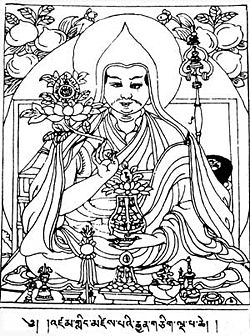
The Dual System of Government is the traditional diarchal political system of Tibetan peoples whereby the Desi (temporal ruler) coexists with the spiritual authority of the realm, usually unified under a third single ruler. The actual distribution of power between institutions varied over time and location. The Tibetan term Cho-sid-nyi (Tibetan: ཆོས་སྲིད་གཉིས་, Wylie: chos-srid-gnyis; alternate spellings include Chhos-srid-gnyis, Chhoe-sid-nyi, and Chos-sid-nyi) literally means "both Dharma and temporal,"[1][2] but may also be translated as "dual system of religion and politics."[3]
Because the ultimate ruler is the patron and protector of state religion, some aspects of the dual system of government may be likened to the Supreme Governance of the Church of England, or even to theocracy. However, other aspects resemble secularism, aiming to separate the doctrines of religion and politics. Under the Cho-sid-nyi, both religious and temporal authorities wield actual political power, albeit within officially separate institutions. Religious and secular officials might work side by side, each responsible to different bureaucracies.
- ^ Sinha, Nirmal C. (1968-11-12). "Chhos Srid Gnyis Ldan" (PDF). Bulletin of Tibetology, Vol. V, No. 3. pp. 13–27. Retrieved 2010-10-18.
- ^ "Tibetan-English-Dictionary of Buddhist Teaching & Practice". Diamond Way Buddhism Worldwide. Rangjung Yeshe Translations & Publications. 1996. Archived from the original on 2010-03-28. Retrieved 2010-10-18.
- ^ "Constitution of the Kingdom of Bhutan (English)" (PDF). Government of Bhutan. 2008-07-18. Archived from the original (PDF) on 2011-07-06. Retrieved 2010-10-13.